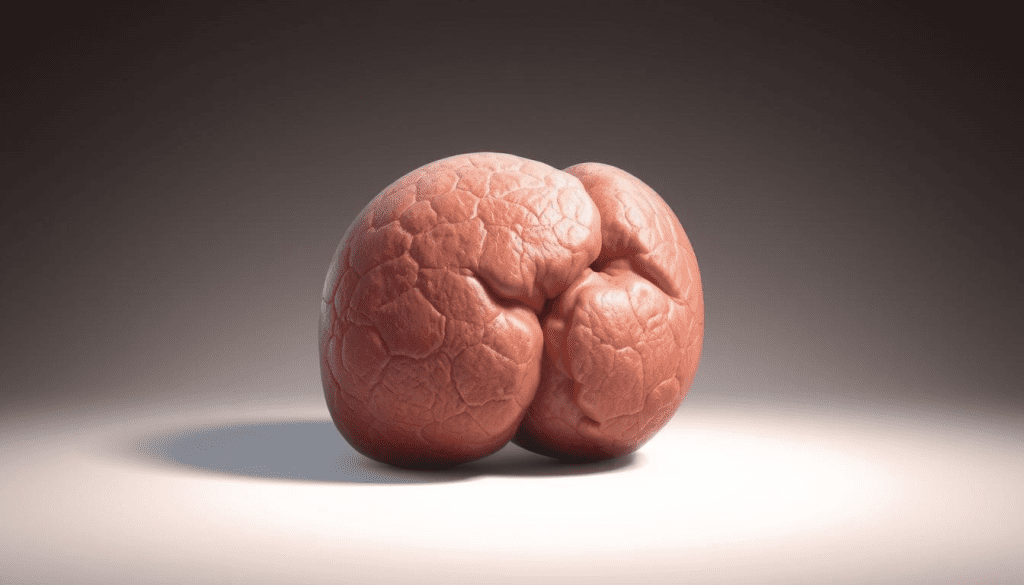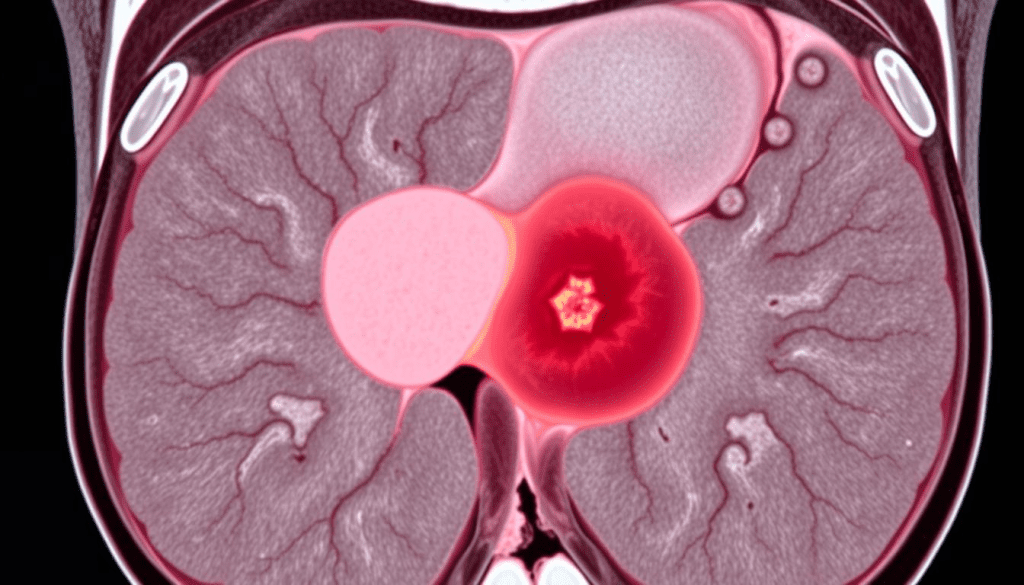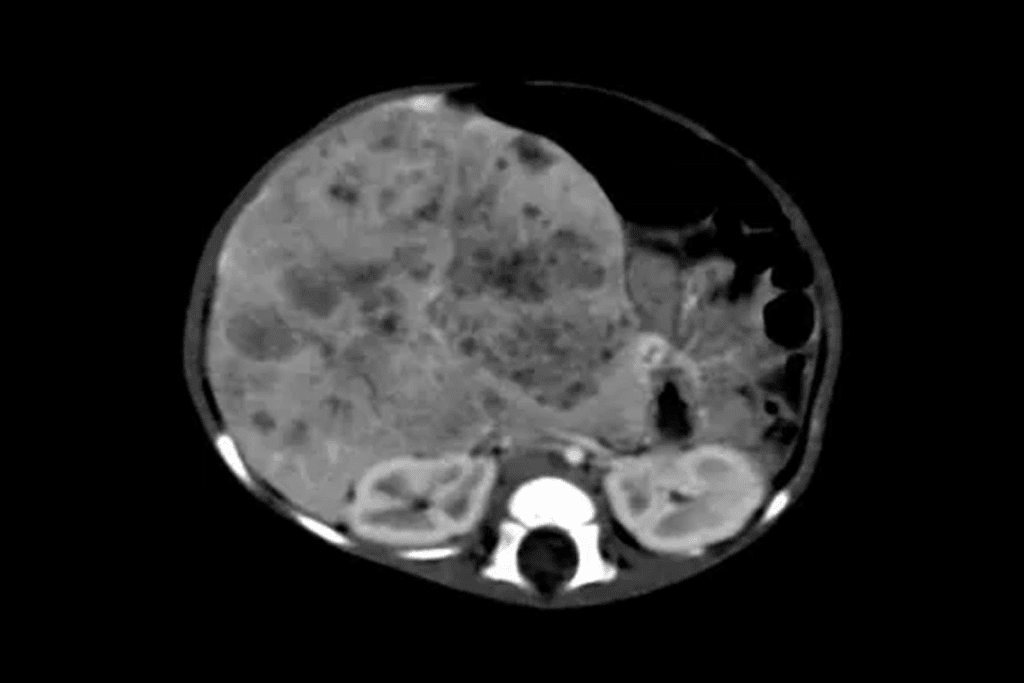Last Updated on November 12, 2025 by
We know that hepatoblastoma, a rare liver cancer, mainly hits kids. It comes in different sizes, which really affects how well the treatment works.
The size of the tumor is key in figuring out how well a patient will do and what treatment they need. Hepatoblastoma tumors can be small, under 5 cm, and have a 97% chance of survival after five years. Or, they can be big, up to 25 cm.

It’s important to know how big and what kind of tumors are. This helps doctors find the best treatment. It also helps improve the liver cancer survival rate by age.
To understand hepatoblastoma, we must first know what it is and its impact. It’s a rare and aggressive liver tumor mainly found in children. We’ll dive into its definition and how common it is to fully grasp this condition.
Hepatoblastoma is a cancer of the liver that mostly hits kids, often in the first year and a half of life. It’s the top liver cancer in kids, making up a big part of liver cancers in young ones. It’s mostly seen in babies and toddlers.
Epidemiological Characteristics:
Knowing about hepatoblastoma’s spread helps catch it early. Accurate diagnosis and understanding its spread are key to treating it.
The importance of hepatoblastoma’s spread is in early detection and screening. Knowing who’s at risk helps doctors spot it sooner.
A liver lesion like hepatoblastoma is serious because it can grow and harm the liver. In kids, finding a liver tumor quickly is vital for their health.
We aim to give top-notch, caring care to those with hepatoblastoma. We know it’s a tough disease and our patients need all the support they can get.
Hepatoblastoma tumors can vary greatly in size when first found. This size difference affects how they are treated and managed.
Some tumors are small, while others can grow up to 25 cm or more. These large tumors are hard to plan for and treat.

Big hepatoblastoma tumors can take up a lot of the liver. Handling these tumors needs a team effort. This includes advanced imaging, special surgery plans, and custom chemotherapy.
Managing large tumors involves:
We handle complex cases of hepatoblastoma, including big tumors. Our team offers full care from start to finish.
The tumor’s size is key in figuring out the patient’s chances and treatment success. Knowing the size range helps us tailor care for each patient.
It’s important to know what affects the size of a hepatic mass on liver. At our institution, we see big differences in tumor in liver sizes when patients first come in.
The age a patient is when they get diagnosed matters a lot. Young kids usually have smaller tumors in liver. Older kids might have bigger masses on the liver.
Early detection in young patients often means smaller lumps on liver. But, older kids might not get diagnosed until their lumps on liver are bigger. This makes treatment harder.

Genetic changes also play a big role in how fast and big a growth on liver tumor gets. Some genetic factors can make tumors grow faster, leading to bigger tumors in liver.
Our team looks at these genetic factors when making treatment plans. We try to understand why tumors grow the way they do. This helps us make plans that fit each patient’s needs.
In short, the size of a hepatoblastoma tumor depends on age and genetics. Knowing these factors helps us treat patients better.
We use top-notch imaging to check the size and spread of hepatoblastoma tumors in the liver. MRI and CT scans are key in measuring these tumors accurately.

Measuring hepatoblastoma right is key for treatment planning. When tumors are found in multiple sites in the liver, knowing their size and location is critical. This helps in planning surgery and understanding the patient’s outlook.
Having tumors in multiple sites makes treatment more complex. It needs a detailed plan for surgery and chemotherapy. Advanced imaging helps pinpoint the tumors’ exact spots and sizes, leading to a more personalized treatment.
When there are multiple tumor sites, the team must think about the liver’s function and how treatment might affect the patient’s life. Our team of experts works together to create a detailed treatment plan.
Advanced imaging is not just for the first check-up. It also helps track how well treatment is working. This allows for changes in the treatment plan as needed. This flexible approach is key to better outcomes for patients with hepatoblastoma.
The PRETEXT staging system is key in checking how much of the liver is affected by hepatoblastoma. At our place, we use it to make treatment plans and give full care.
The PRETEXT system sorts tumors by how many liver sectors they touch. This helps us see how much of the liver is involved and plan the best treatment.
Key aspects of the PRETEXT staging system include:
With the PRETEXT system, we can figure out the stage of hepatoblastoma. Then, we can make a good treatment plan.

Tumor size is a big deal in figuring out the PRETEXT stage. This stage affects treatment plans and how well a patient might do. Bigger tumors usually mean a higher PRETEXT stage, showing more liver involvement.
The relationship between tumor size and PRETEXT stage can be summarized as follows:
Knowing this link is key for doctors to plan the right treatment and guess how a patient will do.
The size of a hepatoblastoma tumor greatly affects a patient’s chances of survival. At our institution, we’ve seen how tumor size impacts outcomes. We stress the need for early detection and customized treatment plans to boost survival chances.
Patients with small tumors, under 5 cm, have a 97% five-year survival rate. This shows how vital early detection is. Small tumors tend to respond well to treatment, leading to better results for patients. Catching the disease early is key to better survival rates.
Larger tumors, on the other hand, are harder to treat and have lower survival rates. They can be tough to remove surgically and complicate chemotherapy. Treating big tumors needs a multidisciplinary approach, combining surgery, medicine, and support care. Despite these hurdles, new treatments are helping patients with big tumors live longer.
Our experience highlights the importance of understanding how tumor size, treatment, and patient factors interact. By taking a personalized treatment approach, we can improve outcomes for patients with both small and large tumors.
Treating hepatoblastoma requires a team effort. This includes surgery, chemotherapy, and new treatments. At Livhospital.com, we focus on a detailed approach to tackle this tough condition.
Planning surgery is key in treating hepatoblastoma. The size of the tumor is very important. Larger tumors need more complex surgery, like liver removal or transplant. We create treatment plans that fit each patient’s needs.
The tumor’s size and where it is affect the surgery plan. MRI and CT scans help us plan. Knowing the tumor’s size and where it is helps us succeed in surgery.
Chemotherapy is a big part of treating hepatoblastoma. We tailor the treatment to the tumor’s size and type. Chemotherapy helps shrink the tumor before surgery, making it easier to remove. We use proven chemotherapy plans and adjust them as needed.
We watch how well the chemotherapy works with regular scans and tests. We change the treatment plan if needed to get the best results and reduce side effects.
For tough cases of hepatoblastoma, new treatments offer hope. Targeted and immunotherapies are being tested as new options. We keep up with the latest treatments and trials to help our patients.
We’re dedicated to giving our patients the best care for hepatoblastoma. We use surgery, chemotherapy, and new treatments together. Our goal is to improve our patients’ chances of success.
The size of hepatoblastoma tumors is key in deciding treatment and outcomes. At Livhospital.com, we are dedicated to improving care for these patients. We aim to offer top-notch healthcare and support for patients from around the world, following the latest standards.
We are always looking to improve and provide ethical, high-quality care. This lets us use the latest research to help children with hepatoblastoma. We aim to better treatment results and support families through tough times.
Our commitment to excellent care is shown in our team approach to treating hepatoblastoma. We believe in working together and using the newest medical science. This way, we can make a big difference in our patients’ and their families’ lives.
Hepatoblastoma is a rare and aggressive liver tumor. It mainly affects children, often diagnosed in the first 18 months of life.
Tumors can range from small, under 5 cm, to large, up to 25 cm or more.
The size of the tumor greatly affects treatment and prognosis. Smaller tumors usually have better outcomes, while larger ones are more challenging to treat.
The PRETEXT system is used to assess liver involvement in hepatoblastoma. It categorizes tumors based on how many liver sectors they involve.
Tumor size is a key factor in survival. Tumors under 5 cm have a 97% five-year survival rate. Larger tumors have lower survival rates.
Advanced imaging is vital for accurately measuring and assessing tumors. This information is essential for staging and treatment planning.
Treatment involves a team effort, including surgery, chemotherapy, and new therapies. Plans are tailored based on tumor size and characteristics.
Large tumors require complex surgeries and often have lower survival rates. Early detection and tailored treatments are critical.
Early detection is key to better outcomes. Smaller tumors have better prognosis and survival rates.
A hepatic tumor is an abnormal growth in the liver. It can be benign or malignant, with hepatoblastoma being malignant.
A liver mass is an abnormal growth that needs evaluation. It can be caused by conditions like hepatoblastoma and requires proper treatment.
Agrawal, S., & Balamurugan, V. (2020). Laparoscopic versus open inguinal hernia repair: A meta-analysis of randomized controlled trials. Journal of Minimal Access Surgery, 16(1), 1“9. https://doi.org/10.4103/jmas.jmas_35_19
Centers for Disease Control and Prevention. (2024). Facts about birth defects. https://www.cdc.gov/ncbddd/birthdefects/facts.html
Hockenberry, M. J., Wilson, D., & Rodgers, C. C. (2019). Wong’s nursing care of infants and children (11th ed.). Mosby. https://www.elsevier.com/books/wongs-nursing-care-of-infants-and-children/hockenberry/978-0-323-54939-5
The Society of American Gastrointestinal and Endoscopic Surgeons (SAGES). (2023). Patient information on hernia repair. https://www.sages.org/publications/patient-information/patient-information-for-hernia-repair-from-sages/
Subscribe to our e-newsletter to stay informed about the latest innovations in the world of health and exclusive offers!